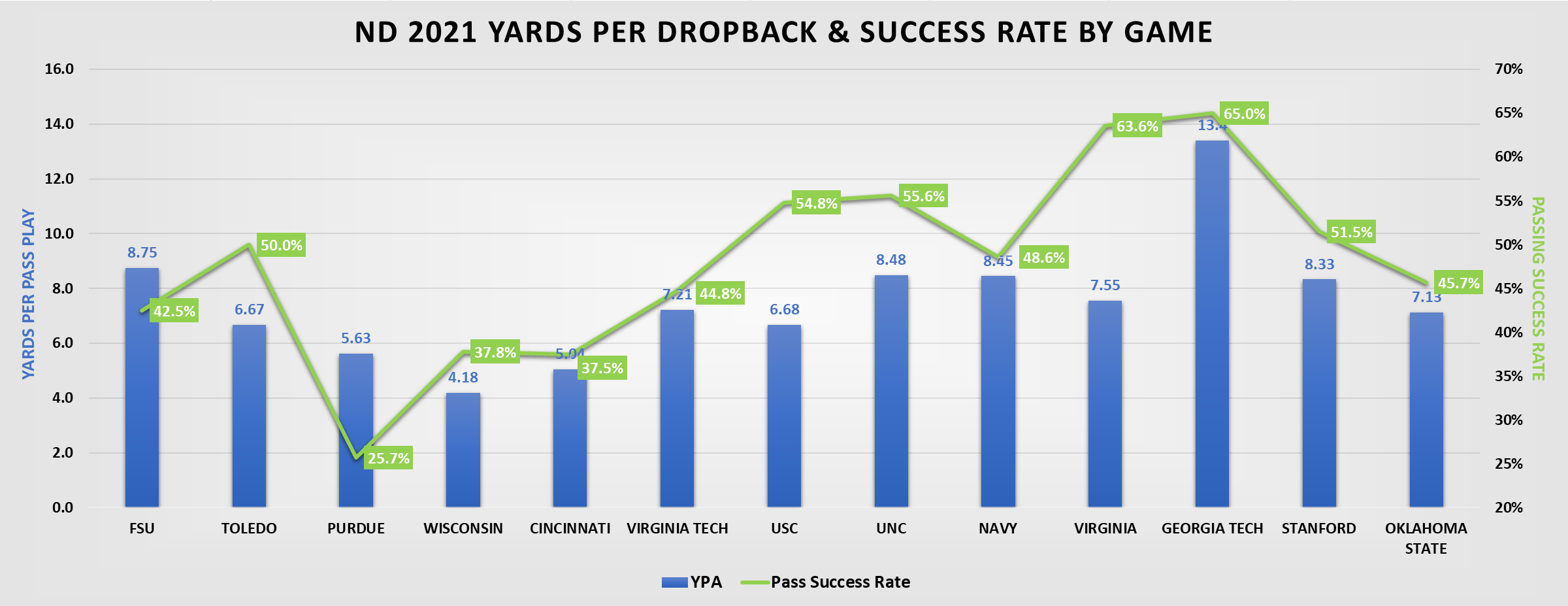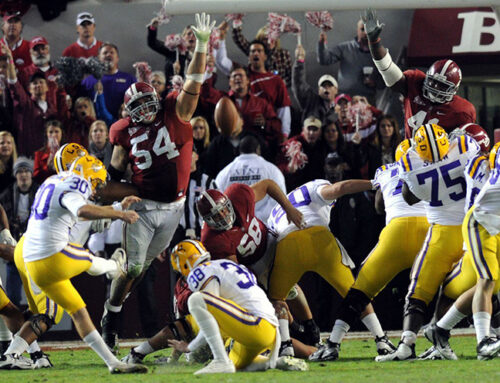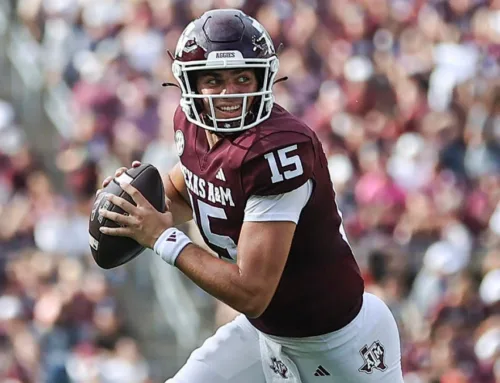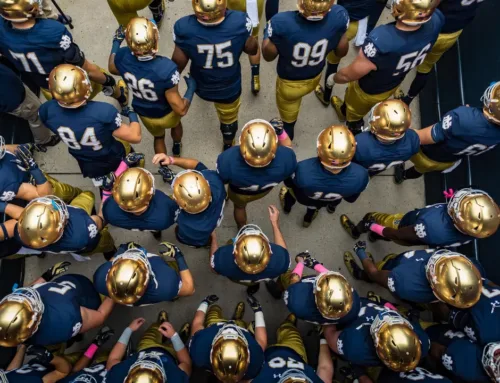This offseason, we’ll be breaking down the performance of each unit – passing and rushing offense and defense – with a look ahead to 2022 and what this means for the Irish. Next is the Notre Dame passing game, which was a wild ride in 2022 with Jack Coan taking time to find his footing and Drew Pyne and Tyler Buchner making strong cases to take over as a starter at different points in the season. Coan rallied down the stretch, buoyed by strong performances by Michael Mayer and Kevin Austin and the emergence of Lorenzo Styles. As the Buchner era looks to begin, how will the passing offense evolve? And what will he have to work with after Austin’s departure to the NFL leaves behind major numbers issues at wide receiver?
Previous entries:
Jack Coan finds his footing
After almost three seasons of relative stability with Ian Book, the 2021 season was a quarterback adventure. The Wisconsin transfer started the season on a high note with a terrific performance in Tallahassee. Still, by halftime of the home opener against Toledo much of his good will had already evaporated. Tyler Buchner flashed his potential that same weekend, and then it was Drew Pyne that looked like he might take over as the starter after successful relief stints against Wisconsin and Cincinnati. The Virginia Tech game encapsulated the early season roller coaster ride – Coan started miserably, was replaced by Buchner who started on fire and then threw two costly picks, and then Coan was heroic leading a comeback win.

As with the rushing game, the passing game transformed after the bye week for USC. Early in the year there was a clear emphasis on the vertical passing game, with shaky results. The line struggled in protection, Coan struggled with the deep ball, and the offense was incredibly inconsistent with no rushing attack to fall back on. After the bye, Tommy Rees reconfigured the offense to give Coan far more rhythm throws in the short to intermediate areas of the field, which paid immediate dividends.

When the dust settled, the Irish passing attack compared pretty favorably to the last few seasons of Ian Book. Down the stretch, the passing game was efficient and pretty explosive, again aided by poor opponent defenses. Pass protection was still an adventure – the Irish finished the season 84th in sack rate allowed, including 94th on passing downs, with plenty of blame to share between the offensive line and Coan. But it was an impressive turnaround for Notre Dame to finish in the top-40 nationally in multiple traditional and advanced stats categories – yards per attempt, passer rating, passing success rate, and pass explosiveness.

If you forced me into a prediction, I’d guess that passing efficiency decreases a bit this fall with a corresponding uptick in explosiveness. Overall passing production might decrease with a more run-heavy attack, but on a per-play basis, I anticipate pretty similar output in 2022.
Solid returning production, but not enough bodies

Notre Dame returns five of its top seven pass-catchers from 2021, which bodes well for surviving Kevin Austin’s departure for the NFL. Great news! Except normally, these returning receivers would be pushed by the following classes of youngtalent, and there are simply not many bodies there. The Irish currently have just seven scholarship receivers entering the summer between injuries, transfers, and position changes.
Back to the positives – Michael Mayer is an absolute monster in the receiving game, building on his ridiculous freshman season last fall. Mayer took on a much heavier workload as a sophomore, nearly doubling his targets and still increasing his yards per pass attempt when targeted. His efficiency when targeted dropped off a bit, but that impact was dulled by increasing his explosive play rate from 12 to 20%. He’s a virtual lock for the first round next year, and a hell of a security blanket for new starter.
Kevin Austin will be missed, and turned out to be a combination of a workhorse with heavy volume and the explosive threat many expected Braden Lenzy to become. Lenzy’s stats when targeted were pretty miserable in 2021 – he caught the lowest percentage of his targets of any main receiver, averaged the fewest yards per target, and had a stunningly low explosive play rate. On the one hand, it was encouraging to see Lenzy demonstrating his evolution as a route-runner beyond the deep ball. On the other hand, the offense could have used a few easy drives, especially early in the year, and Coan and Lenzy struggled to convert those open opportunities.
Avery Davis saw his efficiency when targeted fall off from his days with Ian Book, but like Mayer made up for it with increased explosiveness before his season-ending injury. He’ll be counted on to recover and give the offense a dependable target with some explosive potential.
Lorenzo Styles is going to see his usage rate increase a ton next year. His numbers jump off the chart above – if there’s any reason for caution, it would be that these numbers mostly came against poor defenses in the second half when Coan and the passing game were clicking. But his ability to break long gains both before and after the catch is tantalizing.
After Styles, things get shaky pretty quickly on the receiving depth chart. Deion Colzie was thrust into early playing time last season that hopefully accelerates his growth curve. Jayden Thomas had a nice spring game showing but hasn’t seen real action yet. Tobias Merriweather is a stud but isn’t even on campus yet, and realistically shouldn’t be counted on to contribute until the second half at earliest. There’s a disproportionate amount of pressure on a few veterans with history of battling and recovering from injuries (Davis, Lenzy, and Joe Wilkins) to stay healthy and produce this fall.
The biggest unknown for 2022
The passing game feels like the highest variance area for the 2022 Fighting Irish, and it may not be close. Buchner comes in with a strong pedigree but only 35 career pass attempts. He flashed nice touch on the deep ball, which was a weakness for Coan and Book. But both of his predecessors were very accurate and consistent on short and medium throws – can Buchner move the chains consistently on passing downs?
The pass-catchers feature a good mix of experience and young talent, but wide receiver depth is so incredibly thin. There’s explosive potential – I’m not sure many past Irish receiver rooms have had speed that can rival Styles, Lenzy, and Davis, with Tyree also a threat coming out of the backfield. The receivers should benefit from the offense as a whole stressing opposing defenses – the running game should be formidable, Mayer demands attention, and Buchner’s legs have to be accounted for. But the numbers simply aren’t there to survive any injuries, especially to Styles or the outside receivers. One or two veterans with proven production and decent floors would be a godsend, but at this point things appear quiet in the transfer portal.
Overall, SP+ projects the 2022 Notre Dame offense 22nd in preseason ratings. That feels like a fair assessment for the base case of outcomes, with a few key variables that will swing things from borderline top-10 to a floor of around 40th in FBS:
- Can Buchner and the OL unlock a fairly dominant run game? This would be a pretty massive leap from the struggles of 2021, but a mobile QB and the improvement and expected continuity on the line should unlock sizeable gains. The Irish should be able to impose their will on the ground against most opposing defenses and I’d anticipate the run-pass ratio will closely resemble 2020 vs 2021.
- How much will the passing game threaten opposing defenses? In the first series that Buchner struggles, some tweets will be fired off mentioning Brandon Wimbush. The passing game will need to emerge as a solid counterpunch even if the ingredients are there for a strong running attack. Rees should seek to play to Buchner’s and the personnel strengths, whether that’s a steadier flow of deep throws to force defenses to respect Notre Dame’s speed, funneling targets to Mayer, RPOs, or a crafty screen game to backs and pass-catchers who can make things happen after the catch. If Buchner can consistently make these throws at each level, look out.
- Will the wide receivers hold up over the course of the season? The lack of depth is the obvious way the offense could tank – even in the Fiesta Bowl, Rees didn’t have much choice with just a handful of scholarship receivers but to take his foot off the gas pedal a bit after a pass and motion-heavy first half was incredibly successful. In an ideal world, the speedy receivers offer a steady stream of pre-snap movement for defenses to account for, but it might not be feasible with the current roster’s low numbers and how much it will wear them down over the course of the game. A significant portion of the passing game’s success will hinge on good lucky for this position group and one or two transfer additions for depth and insurance.




I always wanted to see RPOs unleashed with Book. But it seemed like he wasn’t particularly good at the quick option type reads (passing or running). I feel like ISD covered every single play that looked like a read-option (rather than a slow hand-off) or RPO and there just weren’t many.
Now I really want to see RPOs with Buchner. Nothing stops a slow QB from running them, but the added running threat opens up so many more options both for the play call and the in play decision. I can’t wait to see an actual RPO with 3 options.
I think having Styles, who can break short catches for big gains, and Mayer, a vacuum for RPO passes, could be a really effective offense with the running talent we have. Really really hope Buchner can pull this off.
I think Book was pretty good at them, and agree they should have run them more. I think they wanted him to run less on designed plays than Buchner, so TB might stress defenses more. I think Book also was so good in the short to intermediate passing game that they felt they didn’t need to go as heavy on RPOs which may not be the case with Buchner.
I guess I incorrectly inferred that Book wasn’t great because they ran a few, but not many, and most plays that looked like reads usually weren’t.